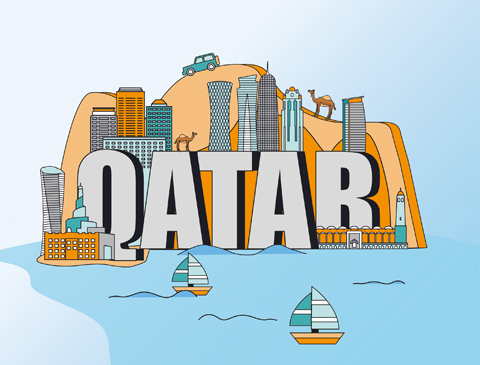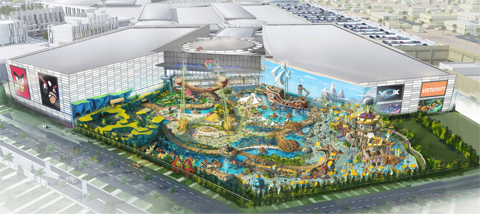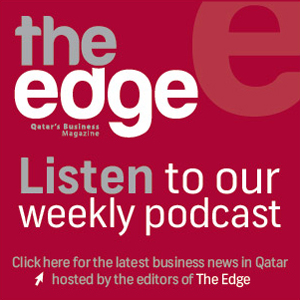State of boredom: Are there enough entertainment choices in Qatar?
Qatar’s diversified population continues to grow, but the country still lacks sufficient recreational facilities - both for locals and for people who visit Qatar for leisure. Syed Ameen Kader analyses the Qatari market, comparing it with its regional neighbours, and concludes that Qatar’s approach to leisure and entertainment is very much rooted in tradition and authenticity, balanced with modern convenience.

With the rapid economic diversification, the needs and lifestyles of Qatar’s urban populace have evolved to a point where there is a compelling need to offer them different types of entertainment and leisure facilities. But, one gets a sense while talking to friends or colleagues, or visiting online forums, that there is a lack of plurality of options when it comes to spending one’s leisure time.
Qatar has some recreational facilities, but those are mostly within shopping malls, which are, in industry parlance called family entertainment centres (FEC). Although the country has many other leisure facilities ranging from water parks, traditional souqs, museums and exhibitions, unspoiled deserts and beaches, through to luxury hospitality and high-fashion offerings, the question is whether those are enough to meet the demands of the local population, let alone the foreign travellers.
Michael Connors, associate director, Faithful+Gould, says, “Currently there are a number of facilities that fulfil the demand. However, the population in Qatar is growing and quickly becoming more diverse with a wide range of nationalities.” He continues that with many population groups – nationals and expatriates – having varying income levels, different customs contributes to differing views on how leisure time is spent. “In addition, the local population in Qatar is increasingly becoming more connected to global trends and reflecting these trends. These factors create challenges in determining how best to cater to the entertainment needs of all going forward,” says Connors. He agrees that there is a gap, and therefore opportunity for developers to bring theme space offers to Qatar that are positioned at accessible price points.

Doha Festival City, scheduled to open in September, includes 38,000 square metres of space dedicated to entertainment, and will soon be home to Qatar’s first Snow Park, in addition to the region’s first Angry Birds theme park, which will feature both indoor and outdoor attractions. (Image Doha Festival City)
In fact, that trend has already started to emerge in the region. The United Arab Emirates (UAE) seems to have taken a lead in this, but others such as Qatar, Saudi Arabia, Bahrain and Oman are also in the process of doing so.
Mat Green, head of Research and Consulting, CBRE Middle East, says, “Over the past decade, the Middle East has seen the rise of multiple major leisure and entertainment attractions, including Aquaventure in Dubai and Yas Waterworld in Abu Dhabi. These developments, along with planned museums and theme parks, now form an integral part of the country’s (the UAE’s) tourism strategy, with countries such as Qatar now also following suit.”
Initially, these attractions were developed as anchor or ancillary components of the malls and hotels. However, more recently, sizeable standalone theme parks have been delivered in Abu Dhabi while Dubai is currently constructing a theme park cluster, the first phase of which is expected to open later this year.
“The latest theme park announcement came from Muscat/Barka, Oman, which intends to build Oman’s first waterpark, while a second water park is planned for Salalah in 2017. The water parks in Barka and Salalah will accommodate 1200 and 500 daily visitors respectively,” says Harmen De Jong, partner, Development Consultancy & Research, Knight Frank.
Like a number of cities within the region, Doha is also undergoing a transformation of its retail and leisure markets amid an ongoing construction boom as the government strives to modernise the city in the build-up to the 2022 World Cup. However, despite some obvious improvements, Green says, Qatar’s recreational and leisure market remains quite limited and is largely concentrated around its shopping malls. But, he says, there are a number of more exciting attractions set for delivery as part of the future destination malls. “This includes the region’s first Angry Birds theme park, which is set to open at the upcoming Doha Festival City (DFC) mall. Other announced projects for DFC include Juniverse, a kids edutainment concept and a snow park,” adds Green.
Speaking to The Edge, Kareem Shamma, CEO, DFC, agrees, “While Qatar does have a certain amount of entertainment, leisure and gaming facilities, which have been introduced relatively recently to the market or indeed are still in the pipeline, they are simply not sufficient to cater to the needs of the existing Doha community or the projected increase in population.”
He says their research has highlighted the need for a wider variety of entertainment options, catering to the different age groups in Doha. “The entertainment industry is showing significant growth, with a larger variety of options being tailored to the very discerning consumer base both in Qatar and the wider Gulf Cooperation Council (GCC),” Shamma adds.
That is what the DFC project looks to capitalise on by including 38,000 square metres (sqm) of space dedicated to entertainment. Scheduled to open in September 2016, the project will feature both indoor and outdoor attractions, and will soon be home to Qatar’s first Snow Park.
Another standalone entertainment project to make a debut in Doha this year is Megapolis, which, according to its developer Palma Hospitality, has been developed after taking into account the specific needs and lifestyles of Doha’s urban and cosmopolitan populace.
Visitors and guests during the opening of Megapolis project in March this year. Located in the heart of Medina Centrale, The Pearl- Qatar, the project spread over 6000 sqm, is one of the largest indoor family entertainment centres in the Gulf Cooperation Council. (Image Megapolis)
Charbel Mhanna, general manager, Palma Hospitality Group, says, “While Qatar has made great strides across all industries in the past few years, there remains a need for dedicated and comprehensive family entertainment centres such as Megapolis that fully cater to the needs of every age group and attract repeat visits.”
Spread over a 6000 sqm area, the company claims, Megapolis is one of the largest indoor family entertainment centres in the GCC, with the capacity to welcome up to 3000 guests at any given moment. The project offers a wide selection of games, attractions and activities including bowling, indoor golf, darts, billiards, karaoke and flight simulators.
Climate and economic factors
As a business model, what has so far worked for developers is a combination of both retail and entertainment: FECs. That is why we see an influx of shopping malls all across the region. This is primarily due to two reasons: one of course is the economic viability; the other is the climatic condition. Summer heat is a deterring factor for this region to develop projects with large outdoor facilities. However, industry experts suggest, there are ways to deal with that. In fact, the summer season is enjoyed by many European travellers, which can be capitalised on by project owners.
Andrew Williamson, head of retail, JLL MENA, says, “To combat the warm climate and provide pleasant outdoor spaces, developers are providing air-conditioned outdoor F&B seating areas and incorporating shaded walkways in their developments. This can be seen with Mall of the World by Dubai Holding where temperature-controlled arcades are being introduced.”
Talking about the climatic condition of Qatar, Shamma of DFC agrees the country has at least eight months of more enjoyable weather. To capitalise on that, he says, “We are delivering unique indoor and outdoor leisure offerings that have been specially developed in, and for, Doha.”
Industry experts suggest that entertainment venues in this region should have both indoor and outdoor spaces to cater for seasonality and nationalities. “Today the tourism industry requires venues to be built to cater for global audiences since the airline network is expanding rapidly and reaching audiences worldwide. Entertainment venues, in order to be economically viable, need to be within a mixed use scheme, ideally encompassing residential, retail and hospitality,” says Filippo Sona, director, head of Hotels (MENA region), Colliers International.
Besides the family entertainment centres, another form of leisure facilities that has been very successful in this region is water parks. Aqua Park Qatar is the first such theme park to be built in Qatar, and is spread over an area of 50,000 sqm.
Instead of water parks, De Jong of Knight Frank suggests, developers could look into various forms of ‘water play’ which require a much lower capital investment and can be enjoyed throughout the year.
“As a business model, the developer needs to consider whether they will operate the attraction themselves or seek a tenant. If doing it themselves, they then need robust operations to manage the attraction properly.” – Michael Connors, associate director, Faithful+Gould.
Besides Megapolis or Aqua Park Qatar, there are not many standalone entertainment facilities in Qatar, primarily due to the economic feasibility factors. Of course, to make a decision on developing a standalone leisure attraction requires deep market knowledge and insight. The potential return on investment, and the risk profile or sensitivity around that, are also some of the key considerations that need to be made before building any such development.
As a business model, Connors of Faithful+Gould suggests, the developer needs to consider whether they will operate the attraction themselves or seek a tenant. “If doing it themselves, they then need robust operations to manage the attraction properly to continually delight and exceed customer expectations. The developer also needs to have a clear lifespan defined for the attraction. They need to decide to exit or refresh at the right time to avoid diminishing returns from a declining asset,” he explains.
According to Green of CBRE, clustering of facilities, such as including hotels and entertainment facilities within destination malls, or combining water parks and resort hotels, is a strategy that has a proven track record in the region, with higher footfall and longer dwell times often achieved as a result. “Hence, this tends to be the preferred strategy over developing standalone facilities,” he suggests.
While the operation of a theme park can be profitable, the high capital expenditure associated with theme parks drive down investor returns. However, theme parks do have a positive economic impact and induce demand for other more profitable sectors such as hospitality and retail. “A well-planned theme park within a larger mixed-use master plan is likely to yield sufficient returns predominantly driven by hotel room nights and spending at retail and F&B clusters,” says De Jong.
Taking a different approach
Both the UAE and Qatar have set ambitious targets to dramatically increase their visitor numbers over the next five years. To achieve these goals, they are developing new tourism drivers and identifying new source markets. While the UAE is building a number of theme parks and water parks in order to meet growing demand from international visitors, Qatar has adopted a different approach. Furthermore, while Qatar’s population is similar to Dubai’s, it attracts less than three million visitors per year, compared to Dubai’s 13 million plus.
“We sense that Qatar has forged its own path in this regard and has carefully considered its position whereas Dubai, for example, has developed something for everyone; a mass-market destination. Qatar, on the other hand, wants to carefully showcase itself to the world in a way that perpetuates its people’s culture, values and traditions,” explains Connors.
Qatar’s unique offering as a tourist destination is rooted in its authentic cultural experiences, family entertainment options, and business events facilitation. A spokesperson from Qatar Tourism Authority (QTA) says their aim is to position Qatar on the map of world-class tourism destinations by promoting the culture, values and traditions of its people. That is why they are working hard to involve homegrown talent in developing Qatar’s tourism sector, to ensure that the country’s heritage and culture is reflected in visitor experiences.
Last year, QTA partnered with Qatar Development Bank and Qatar Business Incubation Center (QBIC) to create QBIC Tourism, a specialised business incubator that enables local entrepreneurs to develop products and services that enhance the Qatar tourism experience. QBIC Tourism officially launched in January 2016, and has already incubated nine tourism start-ups.
Qatar’s approach to leisure and entertainment is very much rooted in tradition and authenticity, balanced with modern convenience. This ethos fits well with the current trend in the experienced world traveller demographic who are commonly seeking unique experiences, while also wanting luxury too.
Connors agrees Qatar should leverage on its strengths. The country is already a mature destination for business tourism, particularly in meetings, incentives, conferencing, exhibitions (MICE), as well as having a growing pedigree in hosting international sporting events. “The average stay is relatively short among these travellers, however. By better promoting its existing leisure offerings among these groups, stop-over durations after events will increase, building momentum towards sustainable growth in leisure tourist numbers,” he adds.
Connors says they expect to see developers bringing more projects and programmes to market that will have a bias towards heritage enhancement and cultural instigation.
There is no doubt that Qatar would benefit tremendously from creating its own localised strategy and model for tourism growth, by taking into account factors that will most significantly impact the future of the entertainment and tourism sectors in the country.
While Qatar is actively directing its efforts on further developing and strengthening its local tourism sectors to move away from being hydrocarbon-based, residents can only hope that sooner or later they will be able to beat their boredom.
Like this story? Share it.





